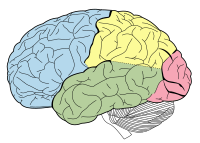
Photo from wikipedia
Significance How bodily arousal states influence decision-making has been a central question in psychology, but the neural mechanisms are unclear. We recorded heart rate (HR), a measure of bodily arousal,… Click to show full abstract
Significance How bodily arousal states influence decision-making has been a central question in psychology, but the neural mechanisms are unclear. We recorded heart rate (HR), a measure of bodily arousal, while simultaneously monitoring neural activity in orbitofrontal cortex (OFC) and dorsal anterior cingulate cortex (dACC) of macaques making reward-guided decisions. In intact macaques, higher HR was associated with shorter reaction times. Concurrently, the activity of a set of neurons in OFC and dACC selectively encoded HR. Following amygdala lesions, HR generally increased, and now the relationship between HR and reaction times was altered. At the neural level, the balance of encoding in dACC shifted toward signaling HR, suggesting a specific mechanism through which bodily arousal influences decision-making. Decision-making and representations of arousal are intimately linked. Behavioral investigations have classically shown that either too little or too much bodily arousal is detrimental to decision-making, indicating that there is an inverted “U” relationship between bodily arousal and performance. How these processes interact at the level of single neurons as well as the neural circuits involved are unclear. Here we recorded neural activity from orbitofrontal cortex (OFC) and dorsal anterior cingulate cortex (dACC) of macaque monkeys while they made reward-guided decisions. Heart rate (HR) was also recorded and used as a proxy for bodily arousal. Recordings were made both before and after subjects received excitotoxic lesions of the bilateral amygdala. In intact monkeys, higher HR facilitated reaction times (RTs). Concurrently, a set of neurons in OFC and dACC selectively encoded trial-by-trial variations in HR independent of reward value. After amygdala lesions, HR increased, and the relationship between HR and RTs was altered. Concurrent with this change, there was an increase in the proportion of dACC neurons encoding HR. Applying a population-coding analysis, we show that after bilateral amygdala lesions, the balance of encoding in dACC is skewed away from signaling either reward value or choice direction toward HR coding around the time that choices are made. Taken together, the present results provide insight into how bodily arousal and decision-making are signaled in frontal cortex.
Journal Title: Proceedings of the National Academy of Sciences of the United States of America
Year Published: 2021
Link to full text (if available)
Share on Social Media: Sign Up to like & get
recommendations!